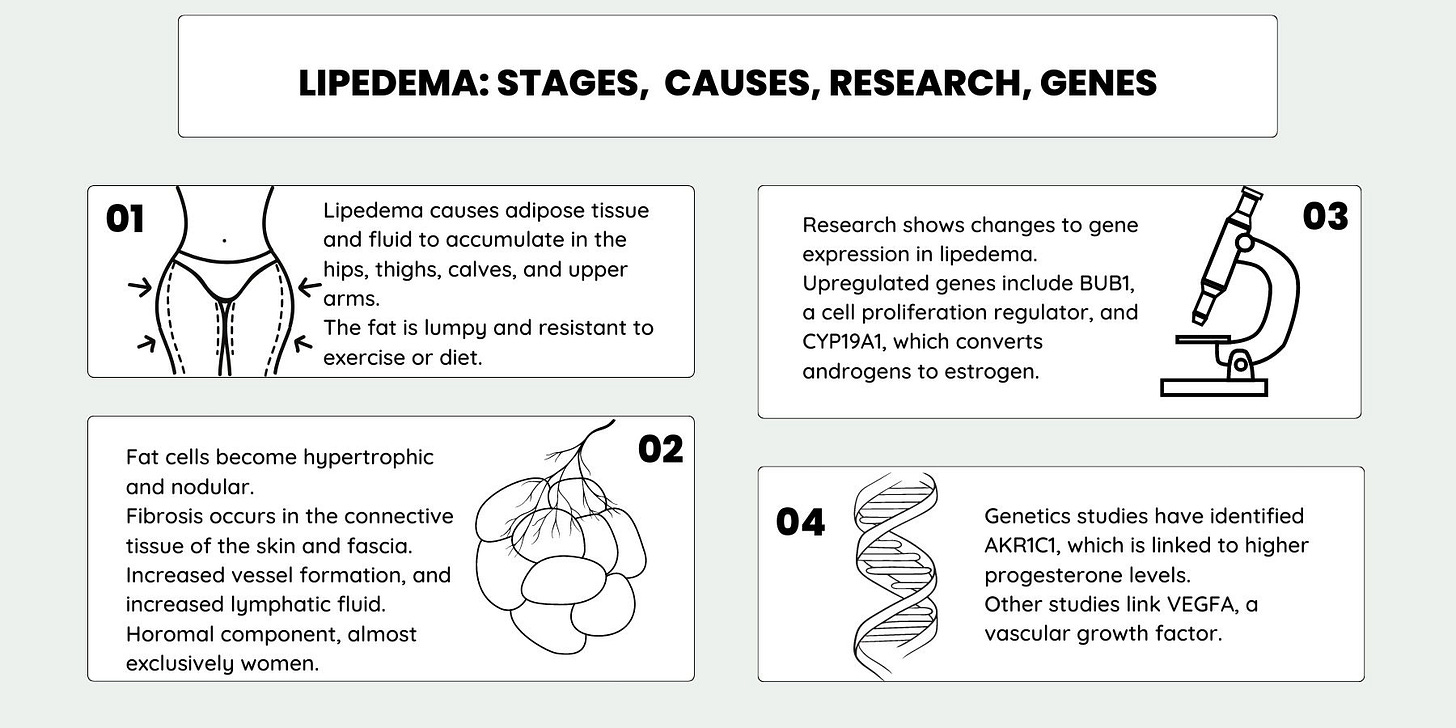Hi everyone,
I hope this finds all of you happy and healthy as we officially get into the summer months here in the northern hemisphere.
Lipedema, which involves the accumulation of lumpy fat under the skin on the thighs, hips, calves, and arms, predominantly affects women after puberty or childbirth. Current studies suggest that it affects approximately 10% of women.
The new article on lipedema is in response to a repeated request from a member. When I initially explored this topic three years ago, there was limited research on the underlying causes. However, recent research has shed more light on the causes of lipedema and potential solutions, even though genetic research is still somewhat scarce.
Additionally, I have updated and revised the article on male pattern baldness for all the guys out there who aren't interested in lipedema. (To be fair, pattern baldness also affects women...) Check it out below if you are interested in why receding hairlines are common -- and what to do about it.
I'm currently working on graphical overviews for articles and printable genotype report overviews. My hope is that it helps to enhance the understanding of complex topics. Let me know if you like these new features or if I'm wasting my time. As always, if you have any questions or suggestions for future topics, feel free to reach out.
Summer is always a bit slow for new memberships on Genetic Lifehacks. If you enjoy the information that I'm providing, I would love your help in spreading the word about the site. It would be great if you would share GeneticLifehacks.com on social media or just tell a friend about it.
Gratefully yours,
Debbie
Lipedema: Genes, Root Causes, Possible Solutions
Key Takeaways:
~ An excess of fat in the legs that is lumpy and painful to the touch can be lipedema.
~ Researchers now believe that lipedema affects ~10% of women.
~ Lipedema involves fluid surrounding hypertrophic fat nodules.
~ Genetics plays a role in who gets lipedema, but the research here is very new and not yet complete.
~ There are some natural supplements and physical options that may help.
Will you go bald? Genetics and hair loss
Key takeaways:
~ Male pattern baldness, or androgenic alopecia, is a condition that will affect the majority of men of European descent by the age of 50.
~ Male pattern baldness affects women as well, usually to a lesser extent.
~ Genetics plays a big role in balding.
~ Importantly, there are personalized ways to counteract your genetic susceptibility.
What I've been reading:
This study came out in April, and it has been nagging at me since reading the abstract that I needed to read the full study, which was behind a paywall. The link above goes to the full study, shared by the author.
The study showed that active energy expenditure (e.g. physical activity) has increased since the 1980s. However, total energy expenditure, which includes the basal metabolic rate along with physical activity, has declined since the 1980s -- paralleling the rise in obesity.
The question then becomes - what is causing the overall decrease in basal metabolic rate?
A common attitude seems to be that the explosion in obesity is due to everyone suddenly becoming lazy, sitting around, and eating lots of junk food. However, calorie consumption overall hasn't changed much and sugar consumption peaked in 1999. (Here's an interesting study in China showing the decrease in calorie intake since 1980, which was likely caused by a shift towards a more urban population.) Plus, this Nature Metabolism study shows that we have more physical activity on average than in 1980...
Everyone seems to have their pet theory - A) the dietary shift towards Omega-6 oils, B) the increase in glyphosate, C) the increase in endocrine-disrupting chemicals, D) the increased exposure to blue light at night... I don't know the answer, but I'm leaning towards E) all of the above.
2. Association of time spent in outdoor light and genetic risk with the incidence of depression
Published in the journal Translational Psychiatry, researchers found that spending time in outdoor light is likely important for preventing depression. The results showed that an hour outside during the winter and two hours of outdoor light in the summer were the sweet spots. The researchers include a polygenic risk score calculation for hospitalized patients with depression. Those with high genetic risk and low exposure to outdoor light were at an even higher risk of depression.
Check out your genes in 9 different pathways that increase depression risk and then go outside for a long walk today.
NAD+ is an essential part of cellular energy production, and NAD+ levels tend to decline with aging. Supplementing with NAD+ precursors such as nicotinamide riboside and NMN is one way of combating the age-related decline. This study also shows that very low amounts of nicotine can also increase NAD+ biogenesis. Important to note the researchers were using very low doses of nicotine in mice that were middle-aged or older. (I'm not proposing that everyone starts smoking in middle age - just thought that the research on a microdose of nicotine was interesting.)






